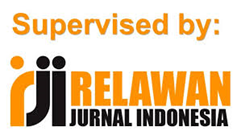THE IMPLEMENTATION OF TOTAL PHYSICAL RESPONSE (TPR) METHOD TO IMPROVE STUDENTS’ VOCABULARY
Abstract, Introduction, Literature Review, Method, Findings and Discussion, References
 PDF Download: 0
PDF Download: 0
DOI:
https://doi.org/10.32665/intens.v1i1.2082Keywords:
vocabulary, total physical response (TPR), clasroom action research (CAR)Abstract
This research aims to determine how the implementation of teaching vocabulary using the TPR method and whether the TPR method can improve the students’ vocabulary. This type of research was classroom action research (CAR). The research was conducted in two cycles. The research subjects were 20 students. Data collection was obtained based on observation, test, and documentation results. The data analysis used is descriptive qualitative and descriptive quantitative. Based on the qualitative data analysis, it shows that the implementation of the TPR method can make students easier to remember vocabulary. The results of the quantitative data analysis showed that the percentage of pre-action scores was 30% of students who passed. After carrying out actions using the TPR method in the learning process, cycle I data increased by 15% to 45% of students who passed. In cycle II, 80% of students passed the test and an increase of 35%. Cycle II was stopped because students had achieved classical mastery 80%/16 of the total number of students in one class, and individual students reached KKM 75. From this data, it can be concluded that the learning was declared complete individually and classically. So, using the TPR method can improve students’ vocabulary.This research aims to determine how the implementation of teaching vocabulary using the TPR method and whether the TPR method can improve the students’ vocabulary. This type of research was classroom action research (CAR). The research was conducted in two cycles. The research subjects were 20 students. Data collection was obtained based on observation, test, and documentation results. The data analysis used is descriptive qualitative and descriptive quantitative. Based on the qualitative data analysis, it shows that the implementation of the TPR method can make students easier to remember vocabulary. The results of the quantitative data analysis showed that the percentage of pre-action scores was 30% of students who passed. After carrying out actions using the TPR method in the learning process, cycle I data increased by 15% to 45% of students who passed. In cycle II, 80% of students passed the test and an increase of 35%. Cycle II was stopped because students had achieved classical mastery 80%/16 of the total number of students in one class, and individual students reached KKM 75. From this data, it can be concluded that the learning was declared complete individually and classically. So, using the TPR method can improve students’ vocabulary.
References
Asher, J. J. (1969). The Total Physical Response Technique of Learning. The Journal of Special Education, 3(3), 253–262.
Bahtiar, Y. (2017). Using the Total Physical Response to Improve Students’ Vocabulary Mastery. SELL Journal: Scope of English Teaching, Linguistics, and Literature, 2(1), 9–23.
Biyansyahna, E., & Maulana, R. (2020). Meningkatkan Kosa Kata Bahasa Inggris Siswa dengan Menggunakan Gambar. Journal Informatic, Education and Management, 2(1), 55–72.
Er, S. (2013). Using Total Physical Response Method in Early Childhood Foreign Language Teaching Environments. Procedia - Social and Behavioral Sciences, 93, 1766–1768. https://doi.org/10.1016/j.sbspro.2013.10.113
Harahap, N. A., & Zulfitri. (2022). Improving The Students’ Vocabulary Mastery Through TPR Method At SMP Negeri 29 Medan Tahun Ajaran 2020-2021. Education Achievment : Journal of Science and Research, 3(2), 1–7.
Ibrohim, A. T., Septianti, A., & Sadikin, I. S. (2018). Students’ Perception Toward Teaching English Vocabulary Through Total Physical Response (TPR) Method. PROJECT (Professional Journal of English Education), 1(2), 145–156.
Juwita. (2019). Improving Young Learners’ Vocabulary Mastery By Using Total Physical Response With Object (Tpr-O) Technique. Institute of Islamic Study (IAIN) Bengkulu.
Khairma, F. S., & Suryana, D. (2018). Implementation of TPR ( Total Physical Response) Method in Learning English in Barunawati Kindergarten. Advances in Social Science, Education and Humanities Research, 337, 257–260.
Khakim, L., & Anwar, C. (2020). Improving Students ’ Vocabulary Mastery Through Total Physical Response Learning Method. 2nd Social and Humaniora Research Symposium (SoRes 2019), 409, 506–512.
Laksana, S. D. (2018). Implementasi Model Discovery Learning dalam Meningkatkan Prestasi Belajar Siswa Kelas IV Madrasah Ibtidaiah (MI) Al-Ma’arif Gendingan Kec. Kedungwaru Kab. Tulungagung Sigit. JIP: Jurnal Ilmiah PGMI, 4(1), 68–80.
Maskor, Z. M., & Baharudin, H. (2016). Receptive Vocabulary Knowledge or Productive Vocabulary Knowledge in Writing Skill, Which One Important? International Journal of Academic Research in Business and Social Sciences, 6(11), 261–271. https://doi.org/10.6007/IJARBSS/v6-i11/2395
Min, Y. (2013). Vocabulary Acquisition : Practical Strategies for ESLStudents. Journal of International Students, 3(1), 64–69.
Mohammadian, A., Mohammadian, S., & Dolatabadi. (2016). The Effect of Affection on English Language Learning of Children with Intellectual Disability Based on Total Physical Response Method of Language Teaching. International Journal of English Language and Literature Studies, 5(2), 92–103. https://doi.org/10.18488/journal.23/2016.5.2/23.2.92.103
Mustika, D. (2022). Improving Student’s Vocabulary Ability Through the Environment Around the School as a Learning Resource in Class VIII B Students at MTs Terpadu of Manba’ul Ulum Klepek. University of Nahdlatul Ulama Sunan Giri.
Rokhmawati, S., & Mastuti, H. (2018). Use of Instagram to Improve Mastery of English Vocabulary. Educational Research Media: Journal of Research in Education and Teaching, 12(2), 196–203.
Rusiana, & Nuraeningsih. (2016). Improving Students’ Vocabulary Mastery through TPR Storytelling. IJELTAL: Indonesian Journal of English Language Teaching and Applied Linguistics, 1(1), 49–61.
Sadikin, I. S. (2016). The Use of Webquest for Teaching English Vocabulary in an EFL Young Learners Context. Proceeding of International Conference on Teacher Training and Education, 1(1), 403–410.
Sariyati, I. (2013). The Effectiveness of TPR (Total Physical Response) Method in English Vocabulary Mastery of Elementary School Children. PAROLE: Journal of Linguistics and Education, 3(1), 50–64.
Shi, T. (2018). A Study of the TPR Method in the Teaching of English to Primary School Students. Theory and Practice in Language Studies, 8(8), 1087–1093.
Susanti, E. (2016). Teaching English Vocabulary Using Total Physical Response (TPR) Method at Elementary School. STKIP Siliwangi Bandung.
Wardani, S. I. (2015). Improving Students’ Vocabulary Mastery Using Word Mapping Strategy. OKARA: Journal Bahasa Dan Sastra, 1(10), 131–140.
 PDF Download: 0
PDF Download: 0













